Bob Clampett’s “Porky’s Poppa” (1938)
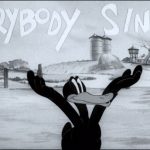
This article was published on my Patreon page in January 2023—with slight modifications in the text here. Since the series is going to the start of Bob Clampett’s directorial career, and for readers to keep abreast of the important details, here’s a link that presents the animator breakdown columns of Clampett’s first season of B&W Looney Tunes in production order. (Animator breakdown columns detailing Porky’s Poppa and Porky’s Five & Ten will be posted here on Cartoon Research next Monday.)
LT-3: Porky’s Badtime Story
LT-4: Get Rich Quick Porky
LT-5: Rover’s Rival
LT-6: Porky’s Hero Agency
LT-7: Porky’s Poppa
LT-8: What Price Porky
LT-9: Porky’s Five & Ten
LT-10: Injun Trouble (also includes its 1945 remake, Wagon Heels)
LT-11: Porky’s Party
LT-12: Porky & Daffy

Like Rover’s Rival and Porky’s Hero Agency, Bob Clampett and Chuck Jones (initialed “C. M.” for Charles Martin [Jones]) share the director’s slot in the production draft for Porky’s Poppa. This confirms another black-and-white Looney Tune where the two acted as a team. This time, no animation start date is listed in the document. Given that Clampett’s unit started animation on a new Looney Tune monthly, the animator’s duties on Poppa could have begun in August 1937, a month after pencil animation on Hero Agency began.
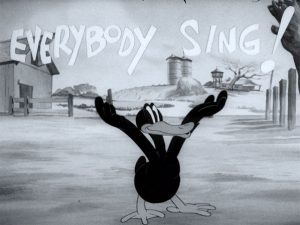 Poppa’s opening begins with a rendition of “Old MacDonald Had a Farm” (sung by The Sportsmen Quartet), which grows more absurd as the barnyard animals exhibit idiosyncratic behavior, in a sharp contrast to straight man Porky. Instead of emitting a “moo” sound, alternate lyrics dictate Bessie the cow to have “a little calf here, and a little calf there”—first showing off her calves, which resemble a shapely woman’s legs; she then displays her two bovine offspring (calves) to the audience in a different scene. A little black duck—not quite Daffy—shouts, in the fashion of a movie theater sing-along in a Donald-like quacking voice, “Everybody sing!” The song concludes with a wild finale; each barnyard animal repeats their actions at super-speed.
Poppa’s opening begins with a rendition of “Old MacDonald Had a Farm” (sung by The Sportsmen Quartet), which grows more absurd as the barnyard animals exhibit idiosyncratic behavior, in a sharp contrast to straight man Porky. Instead of emitting a “moo” sound, alternate lyrics dictate Bessie the cow to have “a little calf here, and a little calf there”—first showing off her calves, which resemble a shapely woman’s legs; she then displays her two bovine offspring (calves) to the audience in a different scene. A little black duck—not quite Daffy—shouts, in the fashion of a movie theater sing-along in a Donald-like quacking voice, “Everybody sing!” The song concludes with a wild finale; each barnyard animal repeats their actions at super-speed.
In Poppa, Porky is portrayed as a young pig with a father. Earlier, in 1936, Porky had a father in two shorts directed by Tex Avery, Porky the Rain-Maker and Milk and Money. Porky’s father returned as Phineas Pig in 1939’s Porky and Teabiscuit (directed by Ben Hardaway and Cal Dalton). Porky’s titular “Poppa” is first introduced as a distraught farmer who frets over the financial woes, with a spoof on the popular radio program/newsreel series The March of Time: “And so today, as it must to all men, debt comes to Porky’s Poppa, 48.”
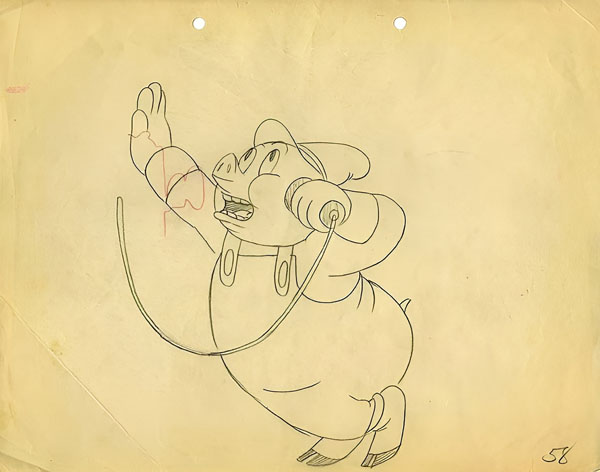
As in Rover’s Rival, Clampett plays on the theme of modernity—here through technological innovation. Porky’s poppa orders a mechanical cow (“The New 1938 Creamlined Cow”) via air mail delivery to replace their old cow Bessie; her milk production is alarmingly low due to literal “hoof ‘n mouth trouble.” As in Rover’s Rival, the young Porky does not spurn Bessie when the “ol’ newfangled heifer” dispenses full milk bottles (and other dairy items) as a mass-production assembly line.
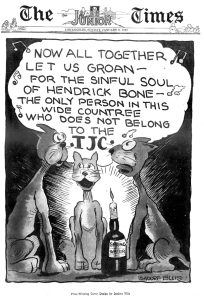 In a sequence animated by Chuck Jones, Porky uses Bessie’s “hoof n’ mouth” disease to his advantage, and nurses her back to health with a large mound of hay. Jones’ animation continues when Bessie “births” milk bottles (“quart-uplets”), each individually wrapped in a newborn’s swaddling cloth; a rather risqué gag unfolds when Porky and Bessie reticently pause their milk production when the old cow produces a chocolate milk bottle, underscored by “Dixie”! A few moments later, Clampett toys with the censorship of cows’ udders, a taboo subject in animated cartoons in the 1930s: a border mask obscures the frame of Porky grasping what appears to be the cow’s anatomy to fill empty milk bottles; the mask opens up to reveal Porky holds a trio of funnels for Bessie to pour the liquid from a bucket.
In a sequence animated by Chuck Jones, Porky uses Bessie’s “hoof n’ mouth” disease to his advantage, and nurses her back to health with a large mound of hay. Jones’ animation continues when Bessie “births” milk bottles (“quart-uplets”), each individually wrapped in a newborn’s swaddling cloth; a rather risqué gag unfolds when Porky and Bessie reticently pause their milk production when the old cow produces a chocolate milk bottle, underscored by “Dixie”! A few moments later, Clampett toys with the censorship of cows’ udders, a taboo subject in animated cartoons in the 1930s: a border mask obscures the frame of Porky grasping what appears to be the cow’s anatomy to fill empty milk bottles; the mask opens up to reveal Porky holds a trio of funnels for Bessie to pour the liquid from a bucket.
Porky’s Poppa was the first Warner Bros. cartoon with animation by Isadore “Izzy” Ellis, credited for scene 61 towards the end of the film, when the mechanical cow rushes into the barn; she produces a heap of milk bottles, similar to an egg-laying gag in Porky the Rain-Maker (1936). Like Bob Clampett, Izzy started professionally as a young cartoonist in the “Junior Times” supplement of The Los Angeles Times in the late 1920s. Clampett might have recommended Izzy for a job at Ray Katz’s studio based on that connection.
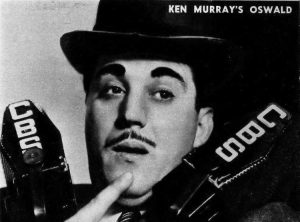
Tony Labriola
Porky’s Poppa was reviewed in The Film Daily on December 23, 1937, before its general release on January 15, 1938. Los Angeles’ Warner Bros. Hollywood and Downtown theaters exhibited the cartoon on January 27, 1938, with the WB feature Hollywood Hotel, and a Warners Technicolor subject, The Littlest Diplomat, with child film actress Sybil Jason.
Below is a reconstruction of the film’s opening that introduces Porky, as shown through Clampett’s story sketches:
Porky’s Poppa (reconstruction w/story sketches):
Porky’s Poppa (animator breakdown):
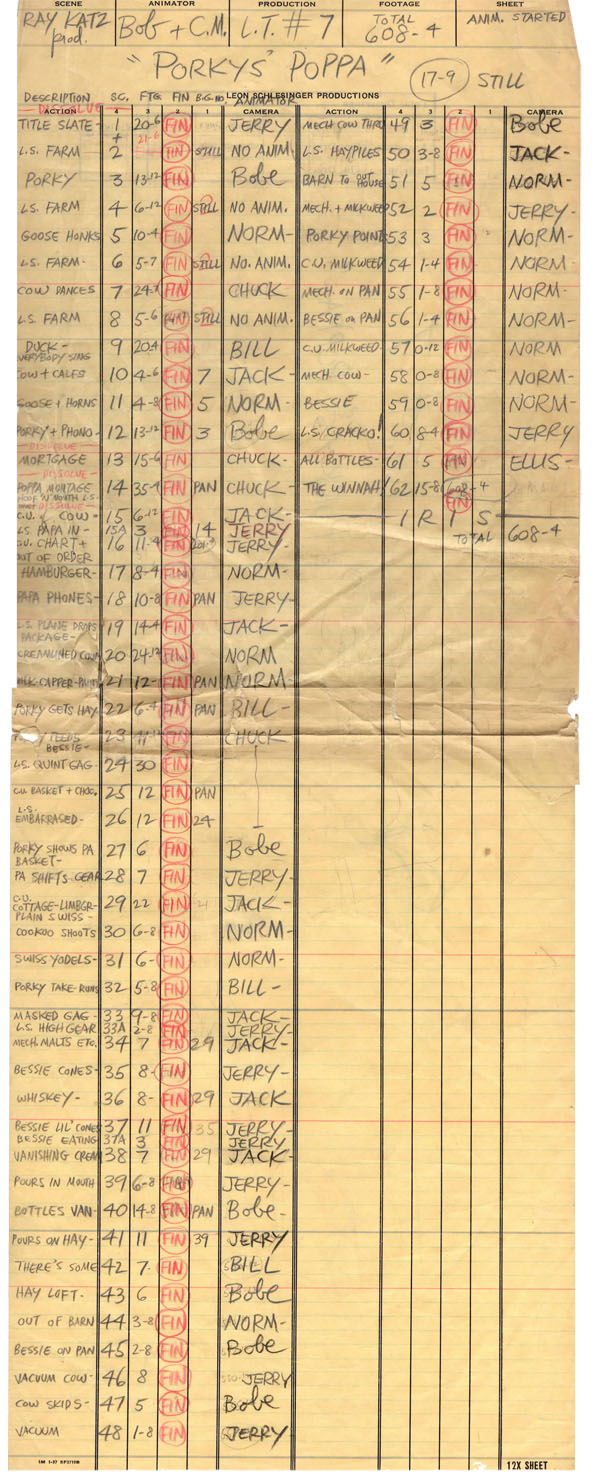
• Thanks to Jerry Beck, Ruth Clampett, Keith Scott, and Frank M. Young for the production materials and information for this post.
